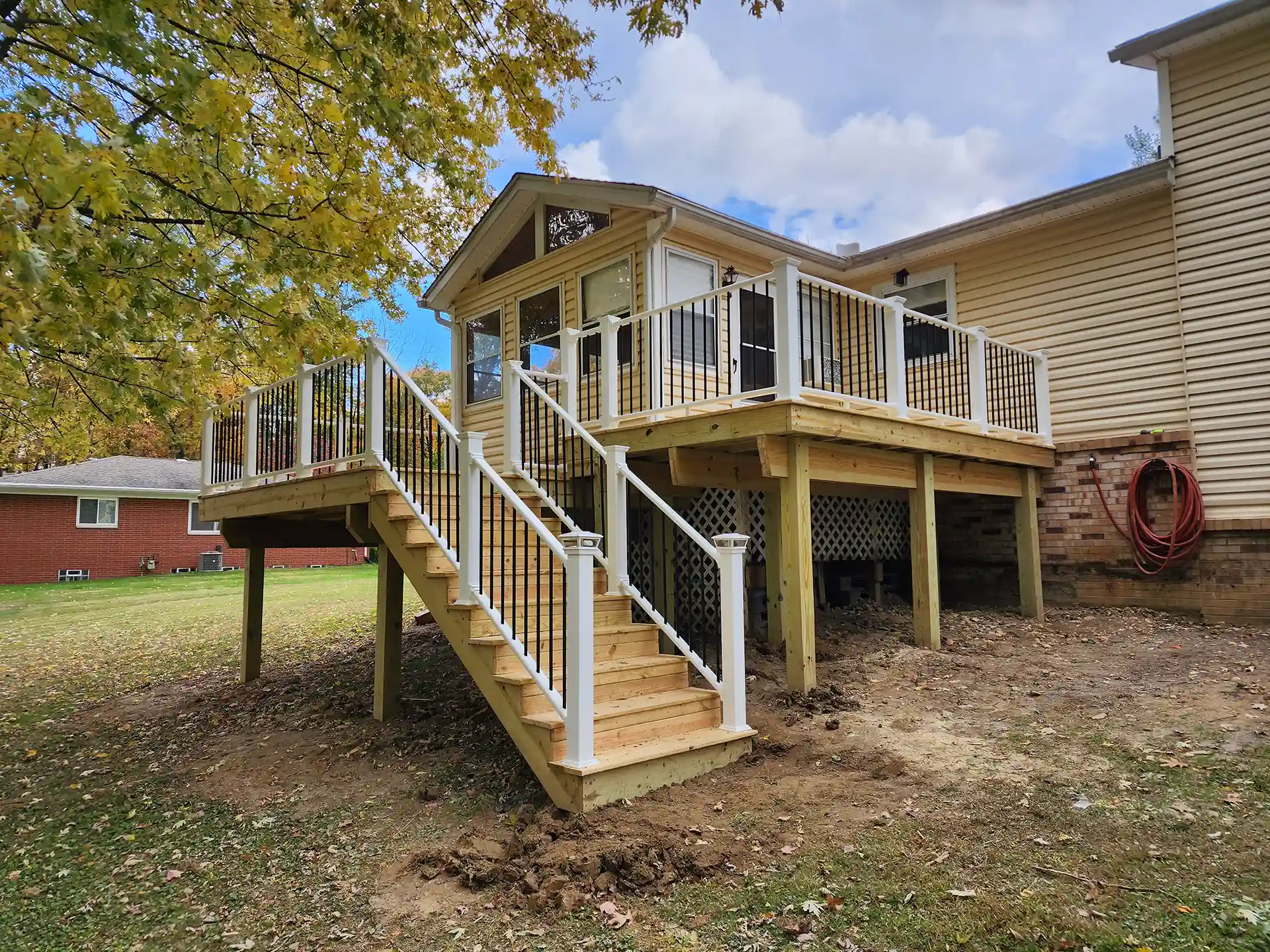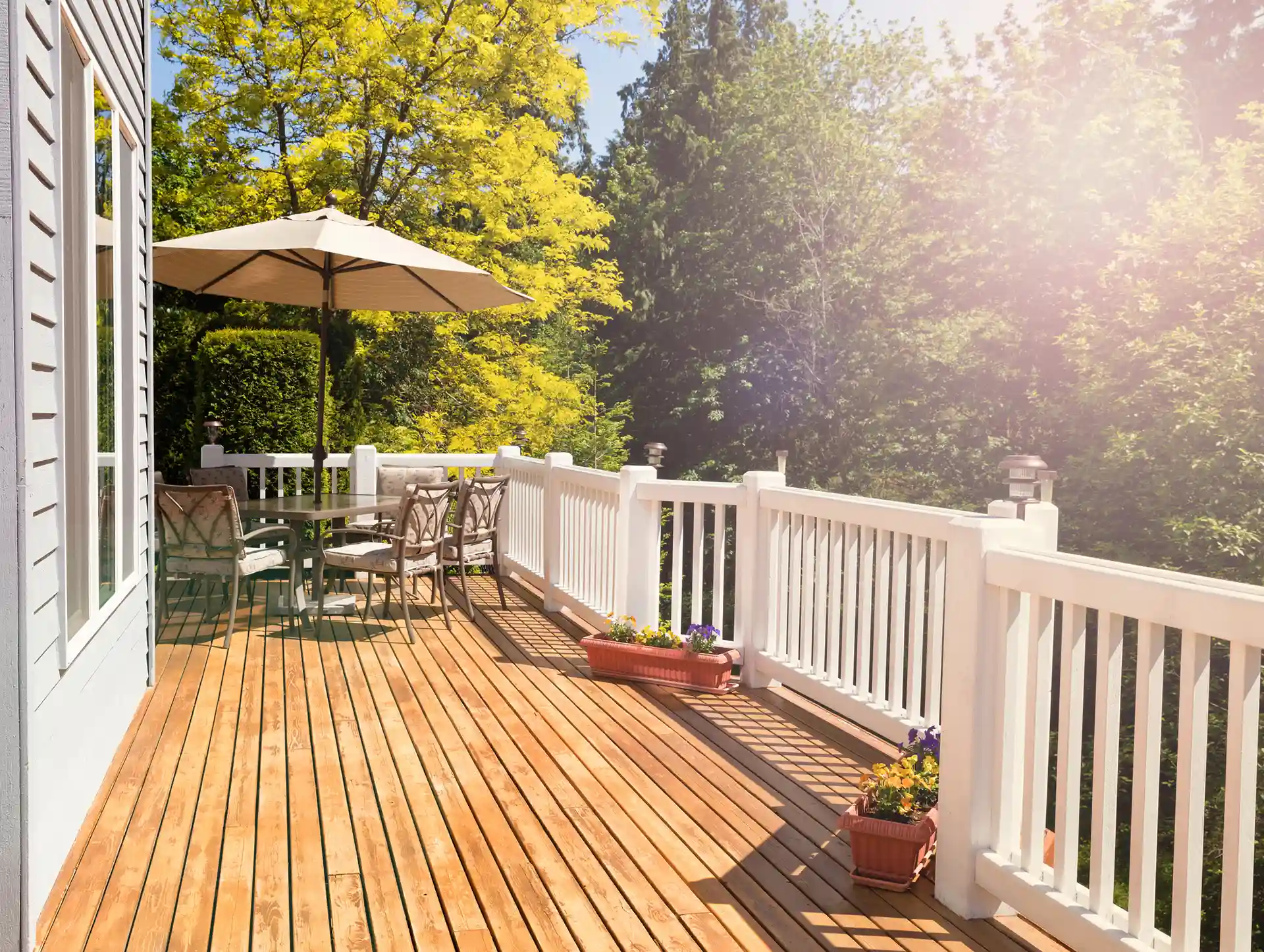Choosing the right material for a deck can feel overwhelming without the right information. Timeless Custom Decks, proudly serving Northeast Ohio, helps homeowners clearly understand their options.
Treated vs. untreated wood for decks is an important topic when deciding how to create a long-lasting and beautiful outdoor space. Knowing the difference between these materials will make the planning process easier and more confident.
What Is Treated Wood?

Understanding treated wood makes it easier to choose the right material for your deck. Pressure-treated wood undergoes a special process to resist rot, insects, and moisture, making it a trusted choice for outdoor structures.
- Chemical Preservation Process: This wood is infused with chemicals under pressure to protect it against decay and pests. This process extends the wood’s usability for outdoor projects in harsh environments.
- Types of Treatment Methods: Wood can be pressure-treated with water-based or oil-based preservatives, depending on the intended use. Each method provides a different level of moisture and insect resistance.
- Common Types of Pressure-Treated Lumber: Builders often use Southern Yellow Pine and Douglas Fir for pressure-treated lumber projects. These woods respond well to the treatment process and offer long-lasting performance.
- Pressure-Treated Wood Applications: This wood is widely used for decks, fencing, retaining walls, and other outdoor structures exposed to the elements. It is valued for its durability and cost-effectiveness.
- Considerations When Using Treated Wood: When planning a project with pressure-treated wood, it is important to use corrosion-resistant fasteners to prevent damage over time.
What Is Untreated Wood?

Untreated wood provides a natural and beautiful material choice for decks and outdoor structures. Without chemical additives, untreated lumber appeals to homeowners who prefer an organic look.
- Natural Beauty: This wood showcases its original color, grain patterns, and textures, adding warmth to any outdoor space. Species like cedar and redwood are especially prized for their appearance.
- Common Types: Cedar is a popular type of natural wood for decks in Northeast Ohio.
- Best Uses: This type of wood is often used for covered porches, indoor-outdoor spaces, and premium decks where natural charm is a priority. It performs best when protected from constant moisture and ground contact.
- Longevity Factors: Choosing the right type of natural wood and maintaining it properly will significantly impact how long it lasts. Regular sealing and proper installation methods help extend its lifespan. Our team at Timeless Custom Decks can help you decide.
- Considerations Before Choosing: Homeowners must weigh the initial investment against the maintenance commitment. Untreated wood requires more attention over time but offers unmatched natural beauty.
Differences Between Treated and Untreated Wood
Understanding the core differences between treated and natural wood helps homeowners make the right choice. Each type has advantages depending on the deck’s location, use, and maintenance plan.
| Feature | Treated Wood | Untreated Wood |
|---|---|---|
| Treatment Process | Infused with chemical preservatives to resist rot, moisture, and insects | Left in its natural state without chemical additives |
| Durability and Strength | Higher resistance to decay, moisture, and pests | Depends on species’ natural oils and density |
| Cost Considerations | Generally more affordable upfront | Premium species are more expensive initially |
| Environmental Factors | Prolongs lumber life, reducing the need for replacement | Appeals to eco-conscious homeowners seeking chemical-free materials |
| Design Flexibility | Uniform structural performance across large projects | Greater variation in color, texture, and appearance |
Benefits of Pressure-Treated Wood
Pressure-treated wood provides strong advantages for homeowners building a deck in Northeast Ohio’s changing climate. Its durability and cost-effectiveness make it a popular material choice.
- Extended Lifespan: Pressure-treated wood lasts significantly longer than untreated wood when exposed to rain, humidity, and pests.
- Affordable Material Option: Homeowners find pressure-treated lumber to be an economical choice without sacrificing performance. It often allows for larger or more complex deck designs within a budget.
- Resistance to Insects and Rot: The treatment process helps prevent termites, carpenter ants, and fungal decay.
- Strong Structural Integrity: Pressure-treated wood maintains its strength under heavy loads and frequent use. It offers peace of mind for homeowners hosting outdoor gatherings and events.
- Availability and Versatility: Pressure-treated lumber is widely available in different sizes and grades. It supports a variety of deck designs from simple platforms to multi-level outdoor living spaces.
Benefits of Untreated Wood
Untreated wood brings natural charm and character to outdoor spaces. For homeowners who value authenticity, it remains a timeless choice.
- Authentic Natural Appearance: The true color, scent, and grain of the wood create a warm and inviting outdoor environment. No two boards look exactly alike.
- Lower Chemical Exposure: Untreated wood avoids synthetic preservatives, making it appealing to homeowners who prioritize environmental sensitivity. It offers peace of mind about material safety.
- Customization Potential: Untreated wood accepts stains, paints, and sealants more easily when properly prepared. Homeowners can personalize the deck’s final look more freely.
- Traditional Craftsmanship Appeal: Many homeowners appreciate the artistry and skill involved in working with untreated wood. It aligns with classical deck-building traditions.
The Appeal of Untreated Wood
Many homeowners are drawn to untreated wood because of its timeless appearance and natural qualities. Choosing untreated wood can reflect a commitment to beauty and tradition.
- Visual Uniqueness: Untreated wood offers unmatched texture and color variation that synthetic materials cannot replicate. Every deck built with natural wood becomes one of a kind.
- Environmentally Mindful Choice: Some homeowners choose untreated wood to minimize chemical use in their homes.
- Rich Aging Process: Untreated wood weathers gracefully, developing a silvery patina over time. This aging process adds character without losing structural integrity.
- Personal Satisfaction: Building a deck from untreated wood delivers a sense of pride and craftsmanship.
Comparing Lifespans: Treated vs. Untreated Wood
Comparing lifespans helps homeowners understand the practical differences between these two options. Durability directly impacts maintenance and replacement costs.
| Factor | Treated Wood | Untreated Wood |
|---|---|---|
| Average Lifespan | 20 to 40 years with regular maintenance | 15 to 25 years depending on species and care |
| Resistance to Moisture | High resistance to rain, humidity, and ground contact | Lower resistance without regular sealing and protection |
| Resistance to Insects | Built-in protection against termites and carpenter ants | Natural resistance varies by species |
| Maintenance Requirements | Periodic inspection and sealing every few years | Frequent sealing, staining, and inspections needed |
| Performance in Harsh Climates | Performs well in freeze-thaw cycles and heavy rain | Vulnerable without consistent upkeep and protection |
Choose the Right Type of Wood for Your Decking Project
Choosing between treated and untreated wood comes down to matching the material with your goals and lifestyle. Timeless Custom Decks can help guide the decision process.
- Consider Project Budget: Treated wood often fits projects that require balancing cost with performance. High-end untreated wood projects require a larger initial investment.
- Think About Maintenance Commitment: Homeowners who prefer low-maintenance decks might favor treated lumber or composite decks.
- Match Style and Design Goals: Natural, rustic, or contemporary designs can benefit from either wood type. Personal preferences and architectural style guide the final decision.
- Evaluate Site Conditions: Decks exposed to ground contact, high humidity, or frequent rain perform better with treated wood or a composite deck product. Covered or elevated decks may succeed with untreated options.
- Consult with Professionals: Deck builders like Timeless Custom Decks provide valuable insights about material choices. A professional evaluation ensures a smarter investment for every homeowner.
Can You Paint or Stain Pressure-Treated Wood?
Homeowners often ask whether pressure-treated wood can be customized. The answer is yes, with the right preparation and timing.
- Wait for Proper Drying: Freshly treated wood contains moisture and chemicals that can interfere with coatings. Waiting several months allows the wood to dry fully before painting or staining.
- Choose the Right Products: Special primers and stains designed for pressure-treated lumber ensure better adhesion and durability. Using the correct materials leads to a longer-lasting, more attractive finish.
Get Started on Treated vs. Untreated Wood for Decks with Timeless Custom Decks
Timeless Custom Decks helps homeowners across Northeast Ohio choose between treated vs. untreated wood for decks with confidence and clarity. Our expert team ensures every project matches your vision, needs, and budget. Contact us today to get started by scheduling a consultation.
Treated vs. Untreated Wood for Decks FAQs
Is pressure-treated wood toxic?
Pressure-treated wood contains chemicals, but modern treatments are considered safe for residential use when handled properly. Protective gear during cutting or sanding is recommended.
Is pressure-treated wood stronger?
Pressure-treated wood retains the strength of its original species but gains additional resistance to environmental threats. Its strength primarily depends on the type of wood used.
How much longer does treated wood last than untreated wood?
Treated wood can last up to twice as long as untreated wood in harsh outdoor environments. Maintenance practices and local climate conditions will influence these outcomes.
Can you use non-pressure-treated wood for a deck?
Non-pressure-treated wood can be used if it is a naturally rot-resistant species like cedar or redwood. Proper design and maintenance remain crucial for longevity.


